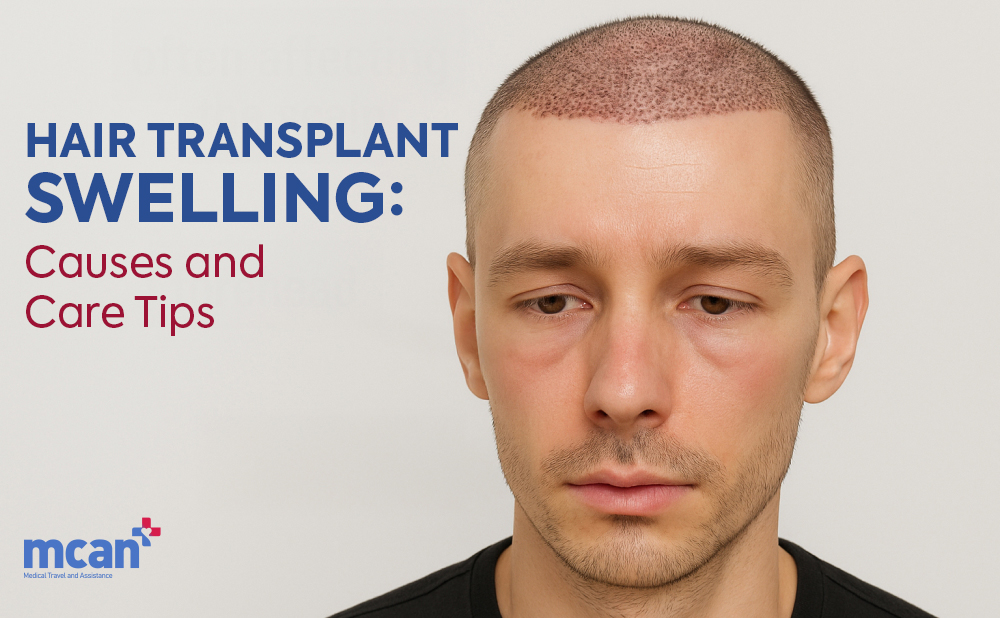
Swelling is one of the most common side effects after a hair transplant and, for many patients, one of the most surprising. It usually develops within the first few days, often affecting the scalp, forehead, and in some cases, the area around the eyes. Although it can look concerning, swelling is a normal response to the procedure and is almost always temporary.
Knowing what to expect and how to care for your scalp during this time can make the healing process more comfortable. By following simple care steps like keeping your head elevated and avoiding intense physical activity—you can help reduce swelling and speed up recovery. This guide explains why swelling happens, how long it lasts, and what you can do to manage it effectively.
What Causes Swelling After a Hair Transplant?
Swelling after a hair transplant is a result of the body’s natural healing response. When grafts are placed into the scalp, the tissues around them react with mild inflammation. This is how your body protects the area and begins the repair process.
Several factors contribute to swelling:
- Inflammation: The immune system increases blood flow to the scalp, which can cause puffiness.
- Fluid buildup: Fluids used during surgery (like tumescent solution) may settle in facial tissues due to gravity.
- Tissue trauma: Micro-incisions during FUE, DHI, or Sapphire hair transplant causes small disruptions in the skin.
Key Causes of Swelling after Hair Transplant:
| Cause | How It Leads to Swelling |
|---|---|
| Inflammation | Body’s response to protect and heal surgical areas |
| Fluid Movement | Gravity pulls fluids down from scalp to forehead/eyes |
| Surgical Technique | FUE and DHI cause micro-trauma that triggers swelling |
| Individual Sensitivity | Some patients naturally swell more due to skin type |

Is It Normal for My Forehead and Eyes to Swell After Hair Transplant?
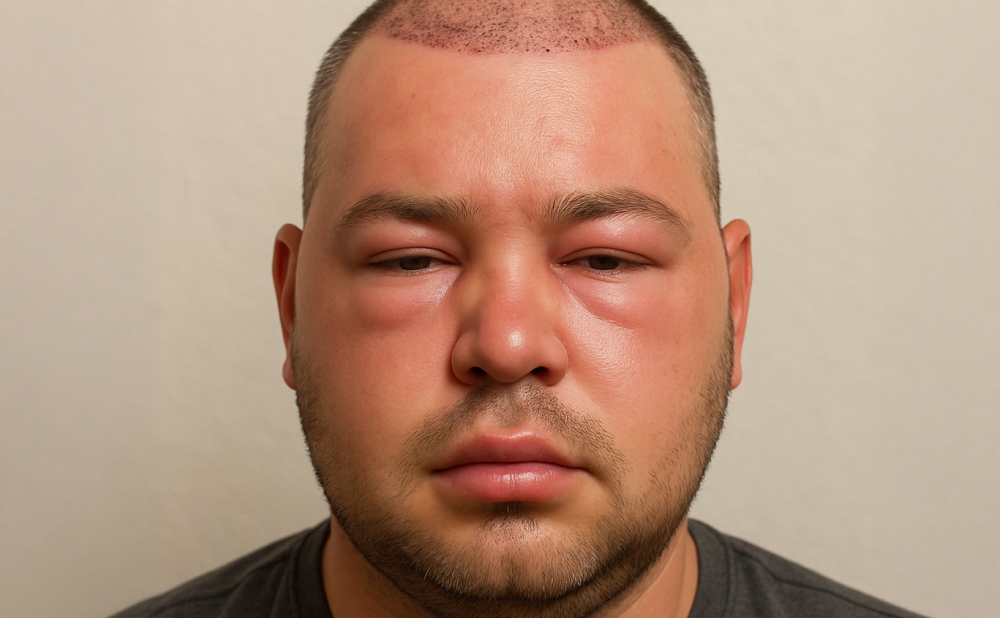
Yes, it’s completely normal for swelling to move from the scalp to the forehead and eyes after a hair transplant. This typically happens between days 2 and 4 and may look alarming, but it’s temporary.
Here’s why:
- Fluids from the scalp shift downward due to gravity.
- The forehead can feel tight, and the eyelids may appear puffy, especially in the morning.
- This swelling usually peaks around day 3 and starts to resolve by day 5–7..
Swelling often moves downward after the procedure, just as scabs form and heal on the scalp. If you’re curious about how scabbing progresses, read our guide on Hair Transplant Scabs: Timeline to Expect Week by Week.
Important: If the swelling is extreme, painful, or lasts beyond 7 days, consult your clinic
When Does Swelling Start, and How Long Does It Last?
Swelling after a hair transplant usually follows a predictable timeline. It doesn’t appear immediately but begins gradually as the body responds to the procedure.
Typical Swelling Timeline:
- Day 1–2: Swelling begins around the forehead or upper scalp. It may be barely noticeable at first.
- Day 2–4: Swelling often peaks. It can spread to the forehead and around the eyes, causing puffiness or tightness.
- Day 5–7: Swelling starts to subside. Most patients notice a significant improvement, with their face returning to normal.
How long swelling lasts can vary depending on:
- The amount of fluid used during surgery
- Individual skin sensitivity
- How well aftercare instructions are followed, especially sleeping position and activity level
To see how swelling fits into the overall recovery process, check out our detailed Hair Transplant Timeline: A Guide to Hair Transplant Recovery & Growth Chart.
Can Swelling Affect My Hairline Appearance?
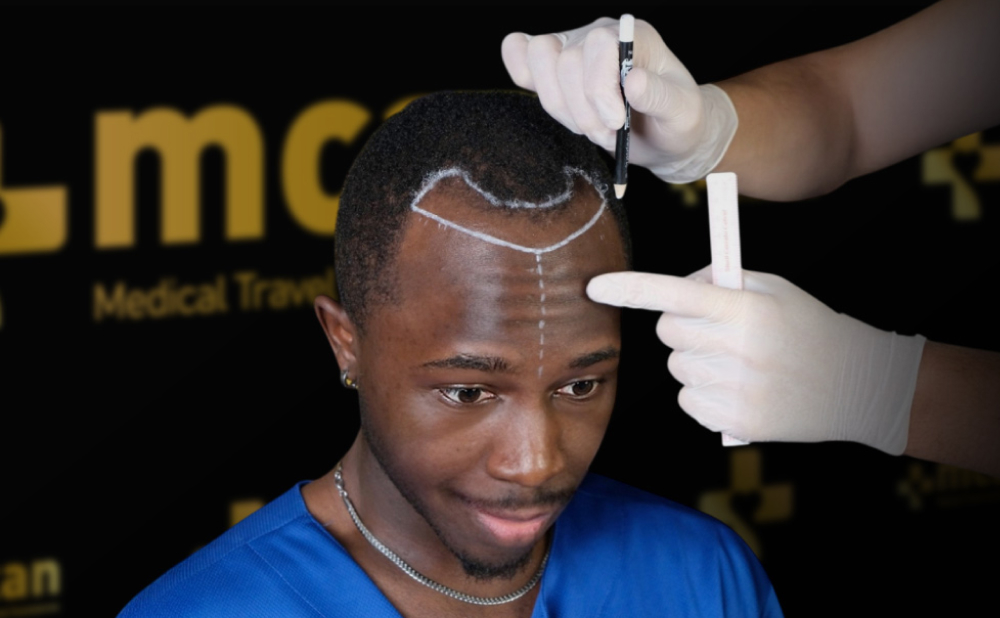
Some patients notice that their hairline appears higher or that the grafted area looks swollen or uneven in the first few days. This is a temporary effect caused by the tightness and puffiness in the surrounding tissues.
Swelling can stretch the skin slightly, making the hairline seem more elevated than expected. As the swelling decreases, the skin relaxes, and the true position of the hairline becomes clearer. It’s important not to judge the results too early—your final hairline will settle as healing progresses.
Changes in hairline appearance early on can be caused by swelling, but shedding is also a normal phase post-surgery. Learn more about this in Hair Transplant Shedding Phase: Does Transplanted Hair Fall Out?.
Is Severe Swelling a Sign of Infection?
Mild to moderate swelling is normal, but severe swelling can sometimes indicate a problem. While rare, excessive swelling accompanied by pain, fever, or redness may be a sign of infection or another complication.
Watch for these signs:
- Swelling that lasts longer than 7 days
- Swelling that worsens after initially improving
- Warmth or throbbing in the swollen area
- Unusual color changes like deep red or purple
- General feeling of illness or fever
Swelling is one of several temporary effects you might experience after surgery. Explore more common reactions in our blog on Hair Transplant Side Effects.
How to Reduce Swelling After Hair Transplant: Care Tips
While swelling is a normal part of recovery, there are several simple and effective ways to reduce it and feel more comfortable during the first few days after surgery. The right care can help prevent swelling from becoming more severe and allow it to resolve more quickly.
Immediate Care Tips:
- Keep your head elevated as much as possible, especially during sleep. Use two or more pillows or rest in a recliner at a 30 to 45-degree angle. This helps prevent fluid from moving down into the forehead and eyes.
- Apply cold compresses to the forehead, just above the eyebrows, for short intervals during the first couple of days. Avoid placing anything cold directly on the transplanted or donor areas.
- Avoid bending over or lowering your head for extended periods. Activities like tying shoes or looking down for long stretches can increase blood flow to the face and worsen swelling.
- Rest and limit physical activity. For the first few days, avoid heavy lifting, cardio workouts, or anything that could raise your heart rate significantly.
Ongoing Care:
- Stay well-hydrated to support circulation and healing. Proper hydration helps the body flush out excess fluids more efficiently.
- Follow any prescribed medication plan given by your clinic. Some patients are advised to take anti-inflammatory medications or corticosteroids to reduce swelling.
- Protect your scalp from the sun, as sun exposure can increase inflammation. If you go outside, wear loose, breathable headwear only after the initial healing period and as recommended by your clinic.
Dos and Don’ts
| Do | Don’t |
|---|---|
| Sleep with head elevated for at least 3–4 nights | Sleep flat or lie on your side in the first days |
| Apply cold compresses to the forehead | Place ice or cold packs on the transplanted area |
| Follow clinic aftercare instructions closely | Ignore signs of excessive or prolonged swelling |
| Avoid strenuous activity for the first week | Resume exercise or heavy work too soon |
| Drink plenty of water | Consume excessive salt or alcohol during recovery |
Preventing Severe Swelling: What You Can Do Before and After Surgery
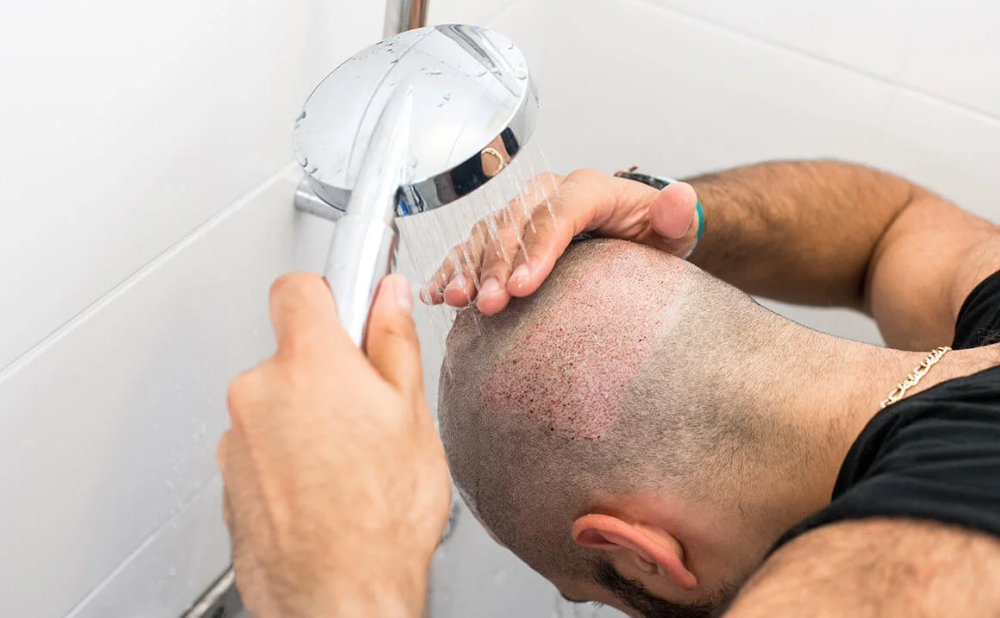
While swelling is a common reaction after hair transplantation, there are steps you can take both before and after the procedure to minimize its intensity. Preparing your body and following early precautions can make a noticeable difference in how your recovery feels and looks.
Before Surgery:
- Talk to your surgeon about your risk of swelling. Some patients are more prone to it, especially if they have sensitive skin or have experienced swelling after other procedures.
- Avoid alcohol and salty foods for at least 24 to 48 hours before your surgery. Both can lead to fluid retention, which may worsen swelling.
- Stay hydrated, but avoid overconsumption of caffeine, which can dehydrate the body and affect circulation.
After Surgery:
- Follow your aftercare plan exactly as provided. Clinics often include detailed steps on how to manage swelling, including when to rest, how to sleep, and which products to use.
- Take prescribed medications if given. Some clinics recommend anti-inflammatory drugs or corticosteroids to control swelling from the start.
- Rest properly for the first few days. Overexertion or lack of sleep can delay healing and increase the body’s inflammatory response.
- Avoid hot showers or steam rooms, as heat can increase blood flow and potentially worsen swelling in the early stages.
Can Sleeping Positions Affect Swelling?
Yes, the way you sleep after a hair transplant can have a significant impact on swelling. In fact, improper sleeping positions are one of the most common reasons why swelling becomes more pronounced or lasts longer than expected.
Why Sleeping Position Matters:
After your procedure, fluids used during surgery and your body’s natural response to healing can cause swelling, particularly in the forehead and around the eyes. Lying flat or sleeping on your side allows gravity to pull these fluids into your face, making puffiness worse.
How to Sleep to Minimize Swelling:
- Keep your head elevated at a 30 to 45-degree angle for at least the first 3–4 nights. This can be done by using extra pillows or sleeping in a reclining chair.
- Avoid sleeping on your side or stomach. These positions can not only increase swelling but also put pressure on the grafted area, which could affect healing.
- Use a neck pillow for added support, especially during the first few nights. This helps prevent accidental turning while sleeping and keeps your head in a stable position.
Are There Medications to Prevent or Control Swelling?
In some cases, clinics may recommend specific medications to help prevent or reduce swelling after a hair transplant. While not everyone will need them, medications can be helpful if you’re prone to more noticeable swelling or want to ease discomfort during the first few days.
Commonly Used Medications:
- Corticosteroids (e.g., Prednisolone): Often prescribed right after surgery to reduce inflammation and prevent swelling from becoming severe. These are usually taken for a short period, as advised by your doctor.
- Anti-inflammatory medications: Non-steroidal anti-inflammatories (NSAIDs) like ibuprofen may be recommended to control mild swelling and relieve tenderness, but only use these if your clinic approves.
- Antihistamines: Occasionally used if swelling is linked to an allergic reaction, though this is rare in standard post-transplant recovery.
What If Swelling Reappears Weeks After My Hair Transplant?
Swelling typically happens within the first week after a hair transplant and resolves quickly with proper care. However, if you notice swelling returning several weeks later, it is not considered a normal part of recovery and should be investigated.
Possible Causes of Late-Onset Swelling:
- Delayed healing response: In some cases, the body may continue to respond to internal inflammation or irritation.
- Infection or folliculitis: Swelling accompanied by redness, pain, or pus could signal an infection in the scalp or follicles.
- Allergic reaction: Sensitivity to a product or medication used after surgery may lead to localized swelling.
- Fluid retention: Rarely, fluid can accumulate again due to systemic issues or lifestyle factors.
Recover Comfortably After Your Hair Transplant in Turkey with MCAN Health
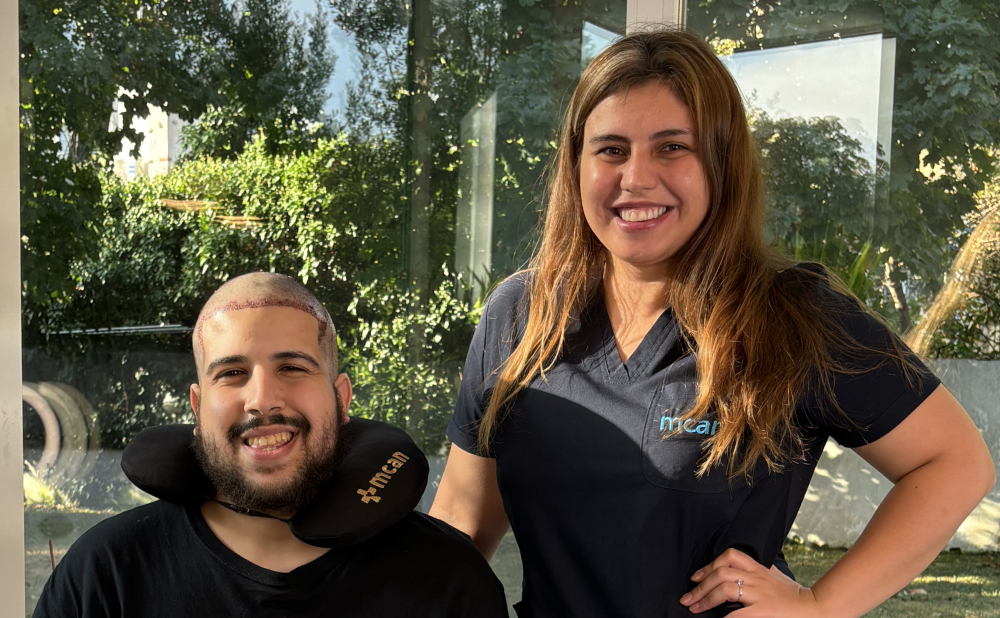
Swelling is a natural and temporary part of the recovery process after a hair transplant. While it can be unexpected, understanding why it happens and taking the right steps can make it easier to manage. With careful attention to aftercare, including proper rest, head elevation, and clinic-guided support, most patients find that swelling resolves quickly without affecting their results.
MCAN Health offers a complete care experience, from advanced surgical techniques to attentive post-operative support. With personalized aftercare plans, daily nurse visits, and 24/7 multilingual assistance, every patient is guided through each phase of healing with confidence and clarity. The team closely monitors recovery progress, helping to minimize side effects like swelling and ensuring a smooth return to normal.
With over 15,000 international patients and a 4.8-star satisfaction rating, MCAN Health is a trusted name in hair transplant in Turkey. Start your journey to a safe, comfortable recovery by booking your free consultation and receiving expert guidance tailored to your needs.
Frequently Asked Questions About Hair Transplant Swelling
How long does swelling last after a hair transplant?
Swelling generally lasts between 3 to 7 days. It typically peaks around day 3 and gradually fades by the end of the first week with proper care.
Can I prevent swelling completely?
While swelling is a natural part of healing, you can minimize it by sleeping with your head elevated, avoiding physical strain, and following your clinic’s aftercare instructions.
Is it okay to use ice on my scalp after surgery?
You should never apply ice directly on the transplanted area. However, using a cold compress on the forehead only can help reduce swelling without harming the grafts.
Does drinking water help reduce swelling?
Yes, staying hydrated supports your body’s ability to flush out excess fluids, which can help swelling subside more quickly.
When can I sleep normally again after a hair transplant?
It’s best to sleep with your head elevated for the first 3 to 4 nights. After that, most patients can return to their normal sleeping position, depending on their healing.
Should I avoid salt to reduce swelling?
Reducing salt intake before and after surgery can help prevent fluid retention, which may lessen the severity of swelling.
Is bruising around the eyes normal with swelling?
Mild bruising can occur along with swelling around the eyes. It usually fades within a few days and is not a cause for concern unless accompanied by other symptoms.
Can heat worsen swelling after a transplant?
Yes, exposure to heat such as hot showers, saunas, or direct sunlight can increase swelling. It’s best to avoid heat for at least the first week.
Do all patients experience the same level of swelling?
No, the degree of swelling varies. Factors like skin sensitivity, surgical technique, and adherence to aftercare all influence how much swelling develops.
What happens if I ignore swelling and don’t follow care tips?
Ignoring swelling can lead to prolonged discomfort and, in rare cases, complications. Proper care helps speed up recovery and ensures the best outcome.
 A Combined Breast Lift with Implants Surgery, Yes or No?
A Combined Breast Lift with Implants Surgery, Yes or No?  Can Everyone Get a Perfect Nose Shape? What Is the Ideal Nose?
Can Everyone Get a Perfect Nose Shape? What Is the Ideal Nose?  Lymphatic Massage After Liposuction, How Often and How Many?
Lymphatic Massage After Liposuction, How Often and How Many?